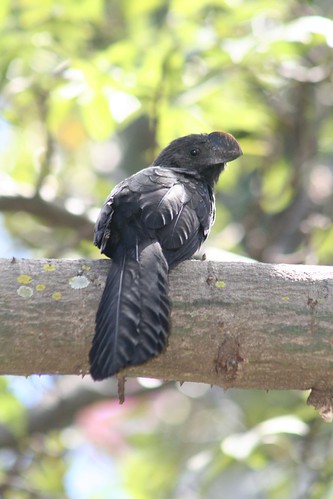
Anu-preto ou Pássaro Preto (Crotophaga ani) - Smooth-billed Ani 080 - 10, originalmente cargada por Flávio Cruvinel Brandão.
The Smooth-billed Ani, Crotophaga ani, is a large near-passerine bird in the cuckoo family. It is a resident breeding species from southern Florida, the West Indies, Costa Rica, Trinidad and Tobago, south to western Ecuador, Brazil and northern Argentina.
This ani is found in open and semi-open country and cultivation. The nest, built communally by several pairs, is a deep cup lined with leaves and placed usually 2-6 m high in a tree. A number of females lay their chalky blue eggs in the nest and then share incubation and feeding.
Each female is capable of laying up to seven eggs, and nests have been found containing up to 29 eggs, but it is rare for more than ten to hatch. Incubation is 13-15 days, with another 10 days to fledging. Up to three broods may be raised in a season, with the young of earlier broods helping to feed more recent chicks.
The Smooth-billed Ani is about 33 cm long and weighs 95 g. The adult is mainly flat black, with a long tail, deep ridged black bill and a brown iris.The flight is weak and wobbly, but this bird runs well, and usually feeds on the ground.
This is a very gregarious species, always found in noisy groups. The calls include a whining ooo-leeek. The Greater Ani feeds on termites, large insects and even lizards and frogs. they will occasionally remove ticks and other parasites from grazing animals.
This common and conspicuous species has greatly benefited from deforestation.
This species called "El pijul" in the Venzuelan folklore. It is mentioned in the popular Venezuelan song "Son Jarocho".
Anú-preto ou Pássaro Preto (Crotophaga ani) - Smooth-billed Ani
Cancioneiro Gaúcho
O Anu
Recolhido de Meyer, Augusto. (1959). Cancioneiro Gaúcho. Porto Alegre: Editora Globo.
1
O anu é pássaro preto,
Passarinho de verão;
Quando canta à meia-noite,
Ó que dor no coração.
2
E se tu, anu, soubesses
Quanto custa um bem-querer
Ó pássaro, não cantarias
Às horas do amanhecer.
3
O anu é pássaro preto,
Pássaro do bico rombudo;
Foi praga que Deus deixou
Todo negro ser beiçudo.
Esta espécie vive em grupos formados geralmente por 7 a 15 indivíduos; à noite os membros do bando dormem sob a folhagem densa de uma mesma árvore e mantêm um território bem definido, com duas áreas: uma para ninhos e pernoite e outra para alimentação.
Alimentação: artrópodes e pequenos vertebrados, saqueando ninhos de pequenos pássaros. Com freqüência capturam alimento no solo, ocasião em que adotam as técnicas "procuradora" e "senta e espera".
Nidificação: o ninho, que é feito com pequenos ramos e folhas, mede cerca de 30 cm de diâmetros por 13 cm de profundidade e abriga ovos de várias fêmeas; cada uma põe de 4 a 7 ovos, podendo o total atingir 20 ovos. Cada um destes, azul-esverdeado e recoberto por uma crosta calcária, mede cerca de 35 x 25 mm, representando 14% do peso da ave adulta. A incubação dura de 13 a 16 dias e os filhotes deixam o ninho com 5 dias de idade; enquanto não voam, permanecem nas proximidades do ninho subindo pelos galhos com auxílio do bico e dos pés.
Cargada por Flávio Cruvinel Brandão el 21 de abr '06, 12:09 PDT.
No hay comentarios:
Publicar un comentario